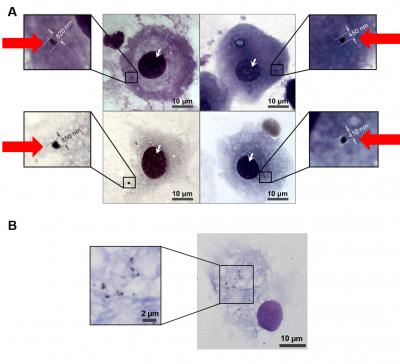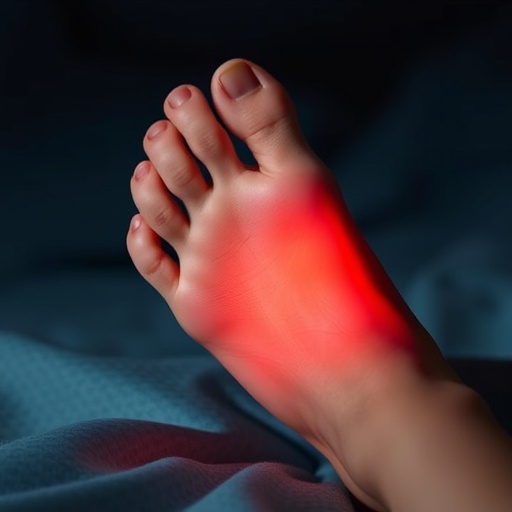Pollution particles, including metals, have been found in the placentas of fifteen women in London, according to research led by Queen Mary University of London

Credit: QMUL
Pollution particles, including metals, have been found in the placentas of fifteen women in London, according to research led by Queen Mary University of London.
The study, funded by Barts Charity and published in the journal Science of The Total Environment, demonstrate that inhaled particulate matter from air pollution can move from the lungs to distant organs, and that it is taken up by certain cells in the human placenta, and potentially the foetus.
The researchers say that further research is needed to fully define the direct effect that pollution particles may have on the developing foetus.
Lead author Professor Jonathan Grigg from Queen Mary University of London said: “Our study for the first time shows that inhaled carbon particulate matter in air pollution, travels in the blood stream, and is taken up by important cells in the placenta. We hope that this information will encourage policy makers to reduce road traffic emissions in this post lock down period.”
Dr Norrice Liu from Queen Mary University of London added: “Pollution levels in London often exceed annual limits and we know that there is a link between maternal exposure to high pollution levels and problems with the foetus, including risk of low birthweight. However, until now we had limited insight into how that might occur in the body.”
Placentas from 15 consenting healthy women were donated to the study following the birth of their children at The Royal London Hospital. Pollution exposure was determined in 13 of the women, all of whom had exposure above the annual mean WHO limit for particulate matter. The cells in the placentas were analysed using a range of techniques including light and electron microscopy, x-rays and magnetic analyses.
Black particles that closely resembled particulate matter from pollution were found in placental cells from all fifteen women and these appeared in an average of 1 per cent of the cells which were analysed.
The majority of particles found in the placental cells were carbon-based, but researchers also found trace amounts of metals including silica, phosphorus, calcium, iron and chromium, and more rarely, titanium, cobalt, zinc and cerium.
Analysis of these nanoparticles strongly suggests that they predominantly originated from traffic-related sources. Many of these metals are associated with fossil fuel combustion, arising from fuel and oil additives, and vehicle brake-wear.
Dr Lisa Miyashita from Queen Mary University of London said: “We have thought for a while that maternal inhalation could potentially result in pollution particles travelling to the placenta once inhaled. However, there are many defence mechanisms in the lung that prevent foreign particles from travelling elsewhere, so it was surprising to identify these particles in the placental cells from all 15 of our participants.”
Fiona Miller Smith, Chief Executive of Barts Charity said: “This is an incredibly important study and immensely relevant to mums-to-be in our local community, indeed in any urban community anywhere in the world.
“In the current climate it can be hard to see beyond COVID and so we are particularly proud to have funded this vital work and truly hope that it will lead to greater awareness of the risks of pollution to the unborn child.”
The study involved researchers from University of Lancaster, Barts Health NHS Trust, University of Manchester, Central Manchester University Hospital NHS Foundation Trust, King’s College London, University of Birmingham, University of Oxford and University of Leeds.
###
For more information, please contact:
Joel Winston
Communications Manager (School of Medicine and Dentistry)
Queen Mary University of London
[email protected]
Tel: +44 (0)7968 267 064
Notes to the editor
* Images of the particles found in the placental cells can be downloaded via WeTransfer here: https:/
Fig. 1. Light microscopy images: (A) macrophage-enriched placental cell isolates from different participants, showing black inclusions (red arrows) compatible with phagocytosed inhaled particulate matter; (B) phagocytosed particulate matter in an airway macrophage obtained by sputum induction from a healthy child in London (Liuetal.,2018). Cell nuclei indicated with white arrows. Brightness and contrast of images were adjusted for optimal visualisation of particulate matter.
Fig. 2. Electron microscopy images of macrophage-enriched placental cell isolates from different participants, showing black inclusions (red arrows) in vacuoles, compatible with inhaled particulate matter.
* Research paper: ‘Evidence for the presence of air pollution nanoparticles in placental tissue cells’. Norrice M.Liu, Lisa Miyashita, Barbara A.Maher, Graham McPhail, Carolyn J.P.Jones, Benjamin Barratt, ShakilaThangaratinam, Vassil Karloukovski, Imad A.Ahmed, Zabeada Aslam, JonathanGrigg. Science of The Total Environment. DOI 10.1016/j.scitotenv.2020.142235
Available here: https:/
About Queen Mary University of London
At Queen Mary University of London, we believe that a diversity of ideas helps us achieve the previously unthinkable.
In 1785, Sir William Blizard established England’s first medical school, The London Hospital Medical College, to improve the health of east London’s inhabitants. Together with St Bartholomew’s Medical College, founded by John Abernethy in 1843 to help those living in the City of London, these two historic institutions are the bedrock of Barts and The London School of Medicine and Dentistry.
Today, Barts and The London continues to uphold this commitment to pioneering medical education and research. Being firmly embedded within our east London community, and with an approach that is driven by the specific health needs of our diverse population, is what makes Barts and The London truly distinctive.
Our local community offer to us a window to the world, ensuring that our ground-breaking research in cancer, cardiovascular and inflammatory diseases, and population health not only dramatically improves the outcomes for patients in London, but also has a far-reaching global impact.
This is just one of the many ways in which Queen Mary is continuing to push the boundaries of teaching, research and clinical practice, and helping us to achieve the previously unthinkable.
Media Contact
Joel Winston
[email protected]
Related Journal Article
http://dx.




